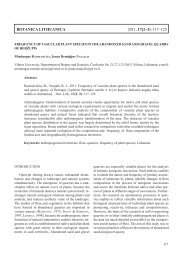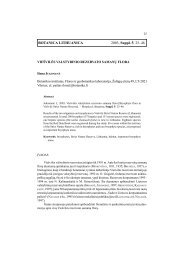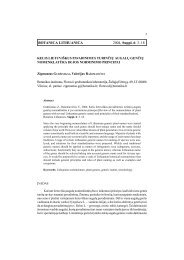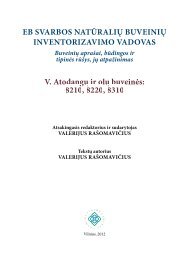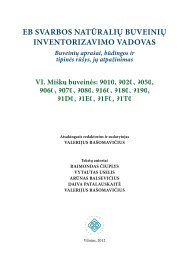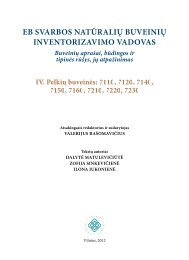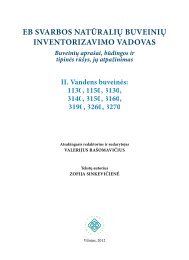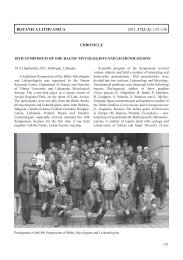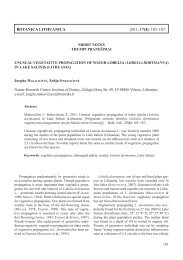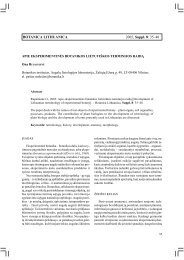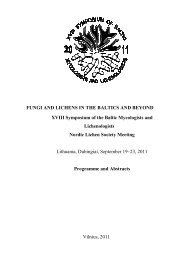BOTANICA LITHUANICA 2005, Suppl. 7: 65–75
BOTANICA LITHUANICA 2005, Suppl. 7: 65–75
BOTANICA LITHUANICA 2005, Suppl. 7: 65–75
- No tags were found...
You also want an ePaper? Increase the reach of your titles
YUMPU automatically turns print PDFs into web optimized ePapers that Google loves.
<strong>BOTANICA</strong> <strong>LITHUANICA</strong> <strong>2005</strong>, <strong>Suppl</strong>. 7: <strong>65–75</strong>SCREENING OF MICROMYCETES PRODUCING TOXIC SUBSTANCES UNDERVARIOUS CONDITIONSAudrius KAÈERGIUS 1 , Albinas LUGAUSKAS 2 , Loreta LEVINSKAITË 2 , Regina VARNAITË 2 ,Audronë MANKEVIÈIENË 3 , Bronius BAKUTIS 4 , Violeta BALIUKONIENË 4 , Daiva BRÛKÐTIENË 51Institute of Botany, Laboratory of Phytopathogenic Microorganisms, Þaliøjø Eþerø Str. 49, LT-08406Vilnius, Lithuania; e-mail audrius@botanika.lt2Institute of Botany, Laboratory of Biodeterioration Research, Þaliøjø Eþerø Str. 49, LT-08406 Vilnius,Lithuania; e-mail lugauskas@botanika.lt3Lithuanian Institute of Agriculture, Department of Plant Pathology and Protection, Instituto Sq.1, LT-58344,Akademija, Këdainiai district, Lithuania4Lithuanian Veterinary Academy, Department of Zoosanitation and Food Products Sanitary, Tilþës Str.18, LT-47181, Kaunas, Lithuania5State Food and Veterinary Service of Republic of Lithuania, National Veterinary Laboratory, J. KairiûkðèioStr. 10, LT-08409, Vilnius, LithuaniaAbstractKaèergius A., Lugauskas A., Levinskaitë L., Varnaitë R., Mankevièienë A., Bakutis B., Baliukonienë V.,Brûkðtienë D., <strong>2005</strong>: Screening of micromycetes producing toxic substances under various conditions[Mikromicetø, ávairiomis sàlygomis gaminanèiø toksiðkas medþiagas, atranka]. – Botanica Lithuanica,<strong>Suppl</strong>. 7: <strong>65–75</strong>.In 2003–2004, micromycetes producing toxic metabolites were isolated from food raw material andvarious sources directly contacting it. Fungi were identified and deposited to the pure culturecollection. Evaluation of factors determining contamination of food products was carried out periodically,beginning with the investigation on contamination of grain, seeds, flax-seeds, vegetables,potatoes, fruit, and finishing up with testing of produced products. It is very important to find out iffungi that contaminate grain or vegetables can produce and excrete toxic substances into surrounding.Some fungal species potential toxin producers were detected both on the surface and inside thegrain. Specific composition of fungi was detected on seeds of rape, maize, soy and their products.The most frequent fungi were as follows: Aspergillus niger, A. clavatus, A. vesicolor, Fusarium oxysporum,F. avenaceum, Penicillium expansum, P. palitans, P. roquefortii, P. viridicatum, Alternariaalternata, Rhizomucor pusillus. These fungi were predominant in the air of grain, vegetable and fruitstorehouses. Micromycetes most intensively producing toxins were detected and intensity of thesynthesis was ascertained. More active strains belong to these species: Alternaria brassicae, A. pluriseptata,Chrysosporium merdarium, Fusarium solani, Fusarim sp. 1-pn, Penicillium expansum,Penicillium sp. sv.-161-1. The most interesting and dangerous are strains producing more than onetoxic secondary metabolite. The thin-layer chromatography constants for secondary metabolites T-2toxin, nivalenol, neosolanol, deoxynivalenol, zearalenone, alternariol, alternuene, tenuazonic acidwere determined. Micromycetes of the Penicillium genus, isolated from various food sources, producedpatulin, penitrem, citochalazin, tenuazonic acid, sterigmatoscistin.Keywords: grain, seeds, vegetables, fruit, mycotoxins, fungi, food, Lithuania.65
INTRODUCTIONMicrobiological contamination of food and aftereffectsare investigated widely in the world, as microorganismsand metabolites of their functional activity arean important source that causes diseases and death ofhumans, loss of natural resources and human-made products.Diversity of microorganisms, their adaptable abilitiesand variable activities cause a great concern topeople and enforce to know more about this aggressivemicrobial world, control its activity, shift it in a desirableway or limit it. These tasks are being solved. Whileconducting the research program “Mycotoxin”, we encounteredwith a very viable and active group of microorganisms– micromycetes. Their biological propertiescapacitate them to adapt to altering environmental conditionsand deteriorate various substrates of plant origin.Due to their activity huge economical losses are caused –every year about 30 % of plant origin products are utilized.Micromycetes can become a cause of ecological problemsand diseases of plants, birds, animals and humansif sanitary norms are not obeyed. An interest in mycotoxins,secondary fungal metabolic products that can besecreted to the environment, has been growing in theworld (LUGAUSKAS et al., 1997; BOUTRIF & BESSY, 2000;SAMSON et al., 2000; DUTKIEWICZ et al., 2001; LUGAUSKASet al., 2002; PARSHIKOV et al., 2002; TAUXE, 2002; THRA-NE, 2004) and means to reduce their negative effect havebeen searched (MILJKOVIC et al., 2003; MANTLE, 2004;TOMA et al., 2004). To solve tasks of this problem, it isaimed to find out micromycetes – the most active producersof mycotoxins, to determine factors influencingspreading of micromycetes and their ability to producemycotoxins, to search or develop a complex of meansenabling to limit or suppress spreading of micromycetesand their functional abilities.The main task of the investigation was to study thediversity of micromycetes in food originated from Lithuaniaand abroad, to detect the most active producers oftoxic compounds, and to ascertain capability of theseto accumulate mycotoxins under various conditions.MATERIALS AND METHODSIsolation and identification of micromycetes. Samplesof grain, seeds, fruit, vegetables and food productsof plant origin were analyzed according to KUDRJAÐEVA(1986), ANDREWS et al. (1997), RABIE et al. (1997) andSAMSON et al. (2000). Fungi were isolated on standardCzapek, Malt Extract Agar (MEA) media. Isolates wereascribed to taxonomic groups following Ainsworth andBisby’s Dictionary of the Fungi (HAWKSWORTH et al.,1995). Micromycetes were identified according to RAP-ER et al. (1965), GAMS (1971), ELLIS (1971, 1976), BOE-REMA & DORENBOSCH (1973), MIL’KO (1974), DOMSCH etal. (1980), PLAATS-NITERINK (1981), RAMIREZ (1982),NELSON et al. (1983), BRANDENBURG (1985), LUGAUSKASet al. (1997), SAMSON et al. (2000). For micromycetes ofFusarium graminearum, F. culmorum, F. avenaceum,F. poae, important in toxigenic respect, identificationwas confirmed by PCR-based technique according toPARRY & NICHOLSON (1996), SCHILLING et al. (1996),DOOHAN et al. (1998) and NICHOLSON et al. (1998).Production of toxins. Screening of micromycetesaccording to their ability to produce toxic metaboliteswas performed by thin-layer chromatography (TLC,ISO standard 8178: 1999). Micromycetes were grownfor 20–25 days on Czapek Yeast Extract (CYA), YeastExtract Sucrose (YES), and standard Czapek agar media(FRISVALD & THRANE, 2000; SAMSON et al., 2000). Briefly,agar plug with mycelium about 8 mm in diameter wascut out of the colony and extracted with 1 ml chloroform/methanolmixture (2 : 1) overnight. The productionof secondary metabolites is usually the highest in thecentre of colony. After extraction 20 µl of extract wasplaced onto TLC plates. For this analysis precoatedplates of silica gel (20 by 20 cm, 0.20 mm thick; Macherey-Nagel)containing a fluorescence indicator (F254)or no indicator were used. The following solvent systemswere chosen: chloroform-methanol (95 : 5) (CHM);toluene-ethyl-acetate-formic acid (5 : 4 : 1) (TEF); benzene-aceticacid (9 : 1) (BAC); toluene-acetone-methanol(5 : 3 : 2) (TAM). After elution and drying, the TLCplates were examined in visible light and in UV-light(UV 254/366 nm). The Rf (a distance of a derivativefrom the start line/a distance of a solvent system fromthe start line) of metabolites was evaluated. Amountsof mycotoxins in different food and grain samples weredetermined by the imunoenzyme analysis method(ELISA). For this purpose, commercial kits Veratox®Alatox(Total), Veratox®Don 5/5, Veratox®Ochratoxin,Veratox®Aflatoxin, T–2 toxin and Zearalenone wereused. Mycotoxins were detected following the manufacturer’sinstructions (R-Biopharm AG, Germany).RESULTS AND DISCUSSIONThe number of humans affected by mycoses and mycotoxicosesis known around the world. Although thetotal number affected is believed to be less than the numberaffected by bacterial, protozoan and viral infections,66
fungal diseases are, nevertheless, a serious health problemin the world. Mycotoxicoses, in contrast, are morecommon in undeveloped countries. The majority of mycotoxicosesis a result of contaminated food. Skin contactwith mould infested substrates and inhalations ofspoil-borne toxins are also important sources of exposure.The phytotoxins produced by fungal pathogens Cochliobolusand Alternaria, for example, have well establishedroles in disease development, and several mycotoxinsof Fusarium species are important in plant pathogenesis(BENET & KLICH, 2003).In the present investigation the detection of mycotoxinproducing fungi and accumulation of toxic compoundswere performed according to the scheme presented inFig. 1.Micromycetes producing toxic metabolites were isolatedfrom food raw material and various sources directlycontacting food raw material. Fungi were identified,and deposited to the collection of pure cultures. Evaluationof factors determining contamination of food productswas carried out periodically, starting with the investigationon contamination of grain, seeds, vegetables,potatoes, fruit and finishing up with testing of producedproducts. Contamination of cereal grain by micromycetesunder various growing and storage conditions wasestimated. It was established that most products made fromquite contaminated grain were not contaminated heavilywith micromycete propagules. Thermal treatment of rawmaterial affects negatively most micromycetes, whichdo not survive; only few propagules can remain. Contaminationof oil crops by micromycetes is rather high, insome cases it reaches 455 ± 35.35 × l0 2 cfu/m 3 and canaffect processed products. Maize, flax-seed, grain of winterwheat and summer barley, processed soy and rapeforage products were contaminated at the different level.Contamination of food products with micromycetes dependsgreatly on abundance of micromycetes in the environment,especially in premises where vegetables arestored, in the air, the contamination of which sometimesreaches 68.8 ± 7.3 × l0 3 cfu/m 3 .It is very important to find out, if fungi that contaminategrain can produce and secrete toxic substances.When barley grain yield of the year 2004 was broughtto storehouses, some fungal species able to produce toxinswere detected on both grain surface and inside thegrain. These were the following: Alternaria alternata,Fusarium avenaceum, F. graminearum, F. poae, F. solani,F. tricinctum, F. sporotrichioides, Penicillium aurantiocandidum,P. expansum and P. funiculosum, etc.The most frequently encountered fungi inside grain werefrom the Alternaria, Ulocladium, Fusarium and Penicilliumgenera. The most abundant group of toxin producersIDENTICIED MONOCULTURES OF MICROMYCETESFig. 1. The scheme of a planned collection of fungi producingtoxic substanceswas among fungi of the Fusarium genus. This propertywas very specific to Fusarium culmorum, F. graminearum,F. sprotrichioides and F. poae (Table 1, Table 2).It was noticed that on cereal grain and their productsfungi such as Aspergillus clavatus, Drechslera sorokiniana,Fusarium poae, Penicillium expansum, Alternariaalternata and Rhizopus oryzae and some strains ofAspergillus niger were prevalent. Such grain, contaminatedwith fungi, is not suitable for use. Micromycetes,mentioned above, also contaminated freshly threshedgrain of wild wheat ‘Spelta’ 75-04 and ‘Spelta’. Micromyceteswere found abundantly on grain of rye, maize‘Target’, spring barley ‘Luokë’. A specific species compositionon seeds of rape, flax-seeds, maize and soy andtheir products was detected. The most frequently foundfungi were Aspergillus niger, Fusarium avenaceum, F. oxysporum,Penicillium expansum, Alternaria alternata,Rhizomucor pusillus, Aspergillus clavatus, A. versicolor,67
Table 1.Chromatographic characteristics (in TEF solvent system) of various secondary metabolites‚ produced in vitro byfungal strains, isolated from food grain (ALN – alternuene; ALT – alternariol; BEA – beauvericin; DAS – diacetoxyscirpenol;DON – deoxynivalenol; FUSX – fusarenone X; NIV – nivalenol; MON – moniliformin; NEO –neosolaniol; T-2 – T-2 toxin; TA – tenuazonic acid; ZEA – zearalenone; unknown – metabolites not identified)No Species Strain Source Constant ofTLC R fSecondarymetabolites1 2 3 4 5 61 F. Fusarium acuminatum acuminatumM4220 Barley 0.55 T-22 F. avenaceum D11-2 Wheat 0.04 MON3 F. culmorum M1318 Barley 0.75 ZEA4 F. culmorum M8312 Barley 0.26 DON5 F. culmorum D11-1 Wheat 0.13 NIV?6 F. culmorum D475 Barley 0.13 NIV?7 F. graminearum M1526 Barley 0.55 T-20.75 ZEA8 F. graminearum M1585 Barley 0.55 T-29 F. graminearum M3125 Wheat 0.26 DON0.75 ZEA10 F. graminearum M1601 Barley 0.26 DON0.55 T-211 F. graminearum M7394 Barley 0.55 T-20.75 ZEA12 F. graminearum M7471 Wheat 0.37 FUSX13 F. graminearum M7871 Barley 0.37 FUSX14 F. graminearum D134 Wheat 0.26 DON15 F. graminearum D304 Wheat 0.26 DON16 F. graminearum M5333 Barley 0.55 T-217 F. graminearum M5283 Barley 0.55 T-218 F. sporotrichioides M1820 Barley 0.55 T-219 F. sporotrichioides M2729 Wheat 0.55 T-220 F. sporotrichioides M2943 Wheat 0.55 T-221 F. sporotrichioides M4277 Barley 0.55 T-222 F. sporotrichioides M5399 Barley 0.55 T-223 F. sporotrichioides M10345 Barley 0.50 DAS24 F. sporotrichioides D344 Wheat 0.55 T-225 F. sporotrichioides M4163 Barley 0.55 T-226 F. poae M802 Wheat 0.55 T-227 F. poae M2665 Wheat 0.55 T-228 F. sambucinum M7393 Barley 0.55 T-229 F. semitectum M2316 Wheat 0.38 BEA?30 F. semitectum M3220 Wheat 0.38 BEA?31 Fusarium sp. M965 Barley 0.28 NEO0.55 T-232 Fusarium sp. M2447 Wheat 0.55 T-233 Fusarium sp. D7–1 Wheat 0.55 DON0.13 NIV?34 Fusarium sp. D11–3 Wheat 0.13 NIV?35 A. Alternaria alternata alternataM532 Vetch 0.58 TA36 A. alternata M751 Wheat 0.58 TA37 A. alternata M960 Barley 0.58 TA38 A. alternata M4036 Wheat 0.72 ALT68
Table 1 (continued).1 2 3 4 5 638 A. alternata M4036 Wheat 0.72 ALT0.58 TA0.38 ALN39 A. alternata M4674 Barley 0.72 ALT0.58 TA40 A. alternata M5011 Barley 0.72 ALT0.58 TA41 A. alternata M5135 Barley 0.72 ALT0.58 TA42 A. alternata M5340 Barley 0.58 TA43 A. alternata M5439 Barley 0.38 ALN44 A. alternata M5649 Barley 0.72 ALT0.58 TA45 A. alternata M5737 Wheat 0.72 ALT0.58 TA46 A. alternata M5819 Wheat 0.58 TA47 A. alternata M7083 Wheat0.72 ALT0.58 TA0.41 unknown48 A. brassicae M5740 Wheat 0.72 ALT0.58 TA49 A. radicina M7088 Barley 0.58 TA50 Drechslera sorokiniana M1545 Barley 0.55 unknown51 D. sorokiniana M5810 Wheat 0.62 unknown52 Ulocladium oudemansii M5642 Barley 0.72 unknown0.60 unknownTable 2.Production of secondary metabolites by fungal strains isolated from food grain. Mycotoxin-producing isolateswere detected by TLC (ALN – alternuene; ALT – alternariol; BEA – beauvericin; DAS – diacetoxyscirpenol; DON –deoxynivalenol; FUSX – fusarenone X; NIV – nivalenol; T-2 – T-2 toxin; TA – tenuazonic acid; ZEA – zearalenone;unknown – metabolites not identified)Species No. Number of isolates of Number No. of mycotoxinproducingof toxin-pro-Mycotoxintested tested isolatesisolatesFusarium acuminatum 2 1 T-2F. avenaceum 20 16 MON, unknownF. graminearum 12 12 T-2, DON, FUSX, ZEAF. culmorum 5 5 DON, NIV?, ZEAF. sambucinum 6 3 T-2, unknownF. semitectum 5 4 BEA?, unknownF. sporotrichioides 36 16 T-2, DAS, unknownF. poae 37 7 T-2, unknownF. tricinctum 2 2 unknownFusarium sp. 16 10 T-2, DON, NIV?, unknownAlternaria spp. 21 16 TA, ALT, ALN, 3 unknownDrechslera sorokiniana 16 2 2 unknownUlocladium oudemansii 6 1 2 unknown69
Penicillium palitans, P. roquefortii and P. viridicatum.These fungi were prevalent in the air of grain, vegetableand fruit storehouses. Thin-layer chromatographymethod was used for the analysis of micromycete capabilityto produce exogenic secondary metabolites. It wasrevealed that more than a half of all tested strains couldproduce more than one metabolite. Only a part of metaboliteswere identified because of the absence of standardtoxins (Table 3).On carrots, kept in storehouse, micromycetes of thePenicillium genus, many of which could be attributed totoxin-producers, were dominant. Penicillium and Aspergillusfungi, which are toxin-producers, mostly damageonions (Aspergillus niger, Penicillium expansum, P. aurantioviolaceum.P. spinulosum). Micromycetes of thePenicillium and Aspergillus genera were prevalent oncabbages stored for different time under different conditions.Fusarium oxysporum, Penicillium expansum, P. fellutanum,P. granulatum, Pythium catenulatum, Rhizopusoryzae and Verticillium alboatrum most often deterioratepotatoes.Micromycetes of 20 genera were isolated from apples.However, their distribution frequency differed.Predominant fungi were Aspergillus niger, Monilia cinerea,Penicillium biforme, P. corymbiferum, P. expansum,P. italicum, Pleospora fructicola and Rhizopus oryzae.The most abundant were Penicillium italicum, P. granulatumand P. corymbiferum.Mostly Penicillium corymbiferum, P. granulatum,P. italicum, P. aurantiovirens, Fusarium moniliforme,Phoma prunicola and Glomerella cingulata fungicontaminated cherry-beries. Toxic micromycetes Penicilliumexpansum, P. italicum and P. martensii deterioratedcurrant-berries most frequently. A direct relationshipbetween capability and intensity of mycotoxinsynthesis and substrate of cultivation of fungal strainsfor longer duration was detected (Table 4 and Table 5).The micromycetes producing toxins most intensivelywere detected, and intensity of the synthesis wasTable 3.Chromatographic characteristics (in BAC solvent system) of metabolites produced by micromycetes on differentmedia (AM – malt agar; CYA – Czapek with yeast extract; YES – yeast extract with sucrose)Fungal species Media Constant of Secondary metabolitesTLC R fPenicillium expansum sv–168-1 AM 0.59 PatulinAM 0.65 CitochalazinAM 0.69 Tenuazonic acid?CYA 0.64 CitochalazinCYA 0.68 Tenuazonic acid?YES 0.57 PatulinYES 0.72 Tenuazonic acidFusarium solani F–08 AM 0.63 Citochalazin?CYA 0.61 Citochalazin?YES 0.56 Patulin?YES 0.62 Citochalazin?Alternaria alternata B–230-1 AM 0.59 PatulinAM 0.65 CitochalazinAM 0.87 PeritremCladosporium chlorocephalum 3-pk AM 0.89 Sterigmatocistin?Ulocladium oudemansii B-230-2 AM 0.72 Tenuazonic acid?AM 0.86 SterigmatocistinAlternaria pluriseptata B-230-3 AM 0.76 Tenuazonic acidAM 0.80 CitochalazinScytalidium lignicola G-453 AM 0.87 Sterigmatocistin?Alternaria sp. M-447 AM 0.83 CitochalazinAspergillus raperi 2-Ši 2-ÐiAM 0.74 Tenuazonic acidAM 0.84 SterigmatocistinChrysosporium merdarium 1-Šal 0.54 Patulin?AM 0.73 Tenuazonic acid70
Table 4.Amounts of mycotoxins produced by fungi on different substrates (DON – deoxynivalenol; ZEA – zearalenon;PAT – patulin)Species Substrate Toxin Amount, (mg/kg)Fusarium solani F-08 Potatoes DON 0.02ZEA 0.0022T-2 0.008Carrot DON 0.33ZEA 0.065Kernels DON 0.04ZEA 0.0Penicillium expansum sv-168-1 Potatoes PAT 0.025Carrot PAT 0.008Kernels PAT 0.013Table 5.Ability of Penicillium micromycetes to produce toxins according to TLC resultsSpecies Source ToxinPenicillium expansum N1 Pease ‘Delta’ PatulinP. expansum N2 Apple ‘Lobo’ PatulinTenuazonic acid?P. atramentosum Corn-vetch mix PatulinP. verrucosum Barley PatulinPenitremP. spinulosum Barley bran PatulinCitochalazinP. italicum N1 Apple ‘Lobo’ PatulinP. italicum N2 Apple ‘Korlend’ ‘Kortlend’PatulinP. brevicompactum Apple ‘Kortlend’ PenitremSterigmatocistinTenuazonic acid?Table 6.Ability of Penicillium micromycetes to produce toxins according to ELISA resultsSpecies Ochratoxin (µg/kg) Patulin (mg/kg)Penicillium waksmani 3.2 0.01P. italicum 2.8 0.025P. griseofulvum 5.9 0.008P canescens
ascertained. Micromycetes Alternaria brassicae, A. pluriseptata,Chrysosporium merdarium, Fusarium solani,Fusarium sp. 1-pK, Penicillium expansum, Penicilliumsp. sv.-161-1 are able to produce toxic metabolites intensively.From grain of spring barley ‘Luokë’ and winterwheat ‘Zentos’ micromycetes were isolated, identifiedand their ability to produce deoxinivalenol and zearalenonwas tested. When micromycetes of 12 species ofthe Fusarium genus were tested, it was established thatdeoxynivalenol was produced the most intensively byFusarium sporotrichioides 4 (1.20 mg/kg) and F. equiseti6 (0.800 mg/kg), zearalenon – by F. chlamydosporum7 (0.468 mg/kg) and F. equiseti 6 (0.564 mg/kg). Themost interesting and dangerous are those strains, whichare capable of producing two or more toxic derivatives.Carrying out the screening of mycotoxin’ producentsthe thin-layer chromatography constants for secondarytoxic metabolites (T-2, nivalenol, zearalenon, altemuen,tenuazonic acid) were determined (Table 1, Table 3). Tendifferent micromycetes were detected basing on the toxinsproduced into agar of Czapek-yeast extract (CYA)and Yeast extract sacharose (YES). Using solvent systemsdescribed in the Materials and Methods, 6 derivativesflorescent under UV light from Aspergillus fumigatuswere found. Their Rf was from 0.46 to 0.91. Fusariumsporotrichioides produced 4 derivatives, which Rfwas from 0.13 to 0.89. One derivative (Rf = 0.42) wasidentified as T-2 toxin. Penicillium variabile released4 derivatives, which Rf was from 0.06 to 0.88. The derivative,which Rf = 0.87 was identified as patulin andthe derivative with Rf = 0.88 – penitrem. Fusarium poaeproduced 1 derivative with Rf = 0.87, which was identifiedas T-2 toxin. Penicillium viridicatum secreted 7derivatives, which Rf was from 0.63 to 0.89. The derivativewith Rf = 0.51 was identified as ochratoxin, andthe peripheral derivative with Rf = 0.68 – tenuazonicacid. In the extract of Fusarium tricinctum 2 derivativeswith Rf = 0.14 and 0.89 were detected. The latter derivativewas identified as T-2 toxin. Fusarium equisetiproduced 5 derivatives, which Rf was from 0.14 to 0.89.The derivative with Rf = 0.63 is close to citochalazine.In extracts of Alternaria alternata there were 7 components,one of them (Rf = 0.69) was identified as tenuazonicacid, the other one (Rf = 0.83) – sterigmatocistin,the third one (Rf = 0.63) was close to citochalazin. Trichosporiellacerebriformis produced 7 derivatives withRf from 0.06 to 0.89. The derivative with Rf 0.59 wasclose to patulin. The content of mycotoxins was determinedin wheat bread contaminated by micromycetesFusarium tricinctum, Penicillium variabile and Fusariumsp. In bread samples high amounts of T-2 toxinwere found – 0.9441 and 0.8971 mg/kg. Micromycetesof the Penicillium genus able to produce patulin, ochratoxin,penitrem, citochalazin, tenuazonic acid, sterigmatoxinand other toxins were isolated from variousfood sources (Table 6).The most active ochratoxin producers were Penicilliumgriseofulvum (= P. citreoviride), P. spinulosum,P. waksmani and P. italicum. Micromycetes capable ofproducing a wide spectrum of toxic substances of variouschemical compositions were screened and deposited topure culture collection. According to the obtained datasuch micromycetes were Penicillium expansum sv.-168-1,Penicillium sp. sv.-161-1, Fusarium solani F-08, Alternariaalternata B-230-1, A. pluriseptata B-230-3, Ulocladiumoudemansii B-230-2, Aspergillus (=Eurotium)raperi 2-Sal. Other micromycete strains were weakertoxin producers. Cladosporium chlorocephalum 3-ph,which was spread on barley grain, produced a substance(Rf = 0.89) close to sterigmatoxin. This was specific tostrains Scytalidium lignicola G-453 and Alternaria sp.M-447. It was found out that the same strains growingon different substrates produce different amounts ofmycotoxins such as deoxyvalenol (DON) and zearalenon(Table 7).Contamination of food raw material and products bymicromycetes is determined by their distribution in theenvironment; especially it is evident during storage ofgrain, vegetables and fruit. Just after the transportationof grain yield (2003–2004) to storehouses, several micromycetes– potential producers of toxic metabolites –were detected on both grain surface and inside the grain.These were the following: Alternaria alternata, Fusariumavenaceum, F. graminearum, F. poae, F. tricinctum,F. solani, F. sporotrichioides, Penicillium aurantiocandidum,P. expansum and P. funiculosum. Latercereal grain and their processed products are contaminatedmostly by Penicillium verrucosum, P. variabile,P. expansum, Aspergillus clavatus, A. niger, Drechslerasorokiniana and Rhizopus oryzae, while counts of Fusariumpoae, F. sporotrichioides and Alternaria alternatadecrease. A specific composition of micromycetes wasdetermined on seeds of rape, flax, maize and soy andthe processed products. Fungi Aspergillus niger, Fusariumoxysporum, Penicillium expansum, Alternaria alternata,Fusarium avenaceum, Rhizomucor pusillus, Aspergillusclavatus, A. versicolor, Penicillium palitans,P. roquefortii, P. viridicatum and P. verrucosum weredetected most frequently. These fungi were prevalentalso in the air of grain storehouses as well as in vegetableand fruit storehouses.According to the method of thin-layer chromatographyby FRISVALD & THRANE (2000) exogenic metabolitesproduced by micromycetes, isolated from tested72
Table 7.Ability of Fusarium strains, isolated in 2004 from summer barley ‘Luokë’ and winter wheat ‘Zenta’, to producetoxinsSpecies Source Deoxynivalenol (mg/kg) Zearalenon (mg/kg)Fusarium chlamydosporum Barley 0.06 0.468F. semitectum Barley 0 0F. sporotrichioides Barley 0.045 0.1F. oxysporum Barley 0.025 0.013F. merismoides Barley 0.085 0.002F. poae Wheat 0.07 0F. oxysporum Wheat 0 0F. sambucinum Wheat 0 0.008F. sporotrichioides Wheat 1.20 0.263F. moniliforme Wheat 0 0F. equiseti Wheat 0.8 0.564F. nivale Wheat 0.085 0.0025samples, were analyzed. More than a half (58 %) of allinvestigated fungal strains more or less intensively producedsecondary metabolites, among which from 1 to7 toxic ones were found. Only a part of metabolites wereidentified because of the absence of the standard toxins.The fact that micromycetes produce a wide spectrumof toxins confirms the opinion about risk of toxic fungalmetabolites to human health. It should be noticed thatthis effect manifests slowly only after some time and invarious forms.It was found out that most of micromycetes detectedon food raw material and food products of plant originare able to synthesize one or several toxins. In 2003–2004 these toxic substances were identified:• T-2 (tetraol) – produced by Fusarium graminearum,F. poae and F. sporotrichioides• Fusarenone X – produced by Fusarium graminearum• Nivalenol – Microdochium nivale• Deoxynivalenol – Fusarium graminearum, F. culmorum• Alternuene – Alternaria alternata• Alternariol – Alternaria alternata, A. brassicae, A. cucumerina• Zearalenon – Fusarium tricinctum, F. graminearum,F. lateritium, F. culmorum, F. moniliforme, F. avenaceumand F. sambucinum• Tenuazonic acid – Alternaria alternata, A. brassicae,A. radicina A. longipes, A. tenuissima, Pyriculariaoryzae, Phoma sp.• Patulin – Penicillium expansum, P. claviforme, P. granulatum,P. lanosum, P. mellini, P. cyclopium, P. cyanofulvum,P. roquefortii and Aspergillus clavatus• Penitrem A – Penicillium palitans, P. cyclopium, P. puberulum,P. spinulosum, P. verrucosum• Penitrem B – Penicillium palitans and P. verrucosum• Citochalazin group – Aspergillus clavatus, Metarrhiziumanisopliae, Chaetomium globosum, Drechslerasorokiniana, Phoma sp.• Ochratoxin A – Aspergillus ochraceus, A. sulphureusand Penicillium viridicatum• Ochratoxin B – Aspergillus ochraceus• Aflatoxin B2 – Aspergillus flavus and A. parasiticus• Sterigmatocistins – Drechslera sorokiniana, Aspergillusversicolor and A. ustusThe obtained data on mycotoxin producers and theirtoxins will enable investigators to develop comprehensiveprotection system from mycotoxin contamination;will allow to reduce contamination of food by mycotoxinproducers and with their toxic metabolites in allfood production and sale links. Analysis of the obtaineddata shows that the problem of limitation of spreadingand development of micromycetes in food raw materialand products still remains. To determine effective measuresinactivating development and functional activity ofmicromycetes, it is necessary to investigate diversity ofmicromycetes and their toxic metabolites in food rawmaterial and products. Thus, it is suggested to continuethis investigation in order to develop preventive protectionmeasures enabling to reduce spreading of micromycetesand synthesis of their toxic secondary metabolites.73
REFERENCESANDREWS S., PARDOEL D., HARUN A., TREOLAR T., 1997:Chlorine inactivation of fungal spores on cereal grains.– Int. Journal of Food Microbiol., 35: 153–162.BENET J. W., KLICH M., 2003: Mycotoxins. – Clin. Microbiol.Rev., 16: 497–516.BOEREMA G. H., DORENBOSCH M. M. J., 1973: The Phomaand Ascochyta species described by Wollenweberet Hochapfel in their institute of study on fruit-rotting.– Studies in Mycology, 3.BOUTRIF E., BESSY C., 2000: Global signifance of Mycotoxinsand Phycotoxins. – In: Mycotoxins and Phycotoxinsin Perspective at the turn of the Millennium.Proccedings of the Xth International IUPAc Symposiumon Mycotoxins and Phycotoxins, 21–25th May,2000: 3–16. – Guarujá.BRANDENBURG W., 1985: Parasitische Pilze an Gefasspflanzenin Europa. – Stuttgart–New York.DOMSCH K. H., GAMS W., ANDERSON T. H., 1980: Compendiumof Soil Fungi. – London.DOOHAN F. M., PARRY D. W., JENKINSON P., NICHOLSON P.,1998: The use of species specific PCR based assaysto analyse Fusarium ear blight of wheat. – PlantPathology, 47: 197–205.DUTKIEWICZ J., KRYSINSKA-TROCZYK E., SKOSKA C.,SSITKOWSKA J., SRAZNO Z., GOLEC M., 2001: Exposureto airborne microorganisms and endotoxin inherb processing plants. – Ann. Agric. Environ. Med.,8: 201–211.ELLIS M. B., 1971: Dematiaceous Hyphomycetes. – Kew.ELLIS M. B., 1976: More Dematiaceous Hyphomycetes. –Kew.FRISVALD J. C., THRANE U., 2000: Mycotoxin productionby common filamentous fungi. – In: SAMSON R. A.,HOCKSTRA E. S. (eds.), Introduction to food and airbornefungi: 321–331. – Utrecht.GAMS W., 1971: Cephalosporium. Artige Shimmelpilze(Hyphomycetes). – Jena.HAWKSWORTH D. L., KIRK P. M., SUTTON B. C., 1995:Ainsworth et Bisby’s Dictionary of fungi. (8th ed.). –Cambridge.KUDRJAÐEVA A. A., 1986: Mikrobiologièeskie osnovy sokhranenijaplodov i ovošèei. – Moskva.LUGAUSKAS A. (ed.), 1997: Mikrobiologiniai medþiagøpaþeidimai. – Vilnius.LUGAUSKAS A., PAÐKEVIÈIUS A., REPEÈKIENË J., 2002:Patogeniški ir toksiški mikroorganizmai þmogausaplinkoje. – Vilnius.MANTLE P. G., 2004: Occurrence of renal cancer in malefischer rats given ochratoxin a viamouldy feed upto 2 years: implications for human health and commercialtrade. – In: New Tools for Improving MicrobialFood Safety ant Quality. Biotechnology andMolecular Biology Abstracts. The 19th InternationalICFMH Symposium, 12–16th September, 2004:375. – Portoroz.MIL’KO A. L., 1974: Opredelitel’ mukoral’nykh gribov. –Kiev.MILJKOVIC A., PFOHL-LESZKOWICZ A., DOBROTA M.,MANTLE P. G., 2003: Comparative responses to modeof oral administration and dose of ochratoxin A or necrotoxicextract of Penicillium polonicum in rats. –Experimental and Toxicologic Pathology, 54: 305–312.NELSON P. E., TOUSSON T. A., MARASAS W. F., 1983: Fusariumspecies. – London.NICHOLSON P., SIMPSON D. R., WESTON G., REZANOOR H.N., LEES A. K., PARRY D. W., JOYCE D., 1998: Detectionand quantification of Fusarium culmorum andFusarium graminearum in cereals using PCR assays. –Physiological and Molecular Plant Pathology 53:17–37.PARRY D. W., NICHOLSON P., 1996: Development of aPCR assay to detect F. poae in wheat. – Plant Pathology,45: 383–391.PARSHIKOV I. A., MOODY J. D., FREEMAN J. P., WILLIAMSA. J., HEINZE T. M., SUTHERLAND J. B., 2002: Formationof conjugates from ciprofloxacin and norfloxacinincultures of Trichoderma viride. – Mycologia,94: 1–5.PLAATS-NITERINK A. J. VAN DER, 1981: Monograph ofthe genus Pythium. – Studies in Mycology, 21.RABIE C. J., LÜBBEN A., MARAIS G. J., 1997: Enumerationof fungi in barley. – Int. Journal of Food Microbiol.,35: 117–127.RAMIREZ C., 1982: Manual and Atlas of the Penicillia. –Amsterdam.RAPER K. B., FENNELL D. J., 1965: The Genus Aspergillus. –Baltimore.SAMSON R. A., HOEKSTRA E. S., FRISVAD J. C., FILTENBORGO., 2000. Introduction to Food Airborne Fungi (6thed.). – Utrecht.SCHILING A. G., MÖLLER E. M., GEIGER H. H., 1996:Polymerase Chain Reaction-based assays for species-specificdetection of Fusarium culmorum, F. graminearum,and F. avenaceum. – Phytopathology, 36:515–522.TAUXE R.V., 2002: Emerging foodborne pathogens. – Int.J. Food Microbiol., 78: 31–41.THRANE U., 2004: Food safety. Mycotoxins and theirproducers. – In: New Tools for Improving MicrobialFood Safety and Quality. – Biotechnology and MolecularBiology Abstracts. The 19th International74
ICFMH Symposium, 12–16th September, 2004: 89. –Portoroz.TOMA M. M., RAIPULIS J., KALNINA I., 2004: Does probioticyeast act as antigenotoxin? – In: New Toolsfor Improving Microbial Food Safety ant Quality.Biotechnology and Molecular Biology Abstracts.The 19th Intemational ICFMH Symposium, 12–16 thSeptember, 2004: 15–21. – Portoroz.MIKROMICETØ, ÁVAIRIOMIS SÀLYGOMIS GAMINANÈIØ TOKSIÐKAS MEDÞIAGAS,ATRANKAAudrius KAÈERGIUS, Albinas LUGAUSKAS, Loreta LEVINSKAITË, Regina VARNAITË,Audronë MANKEVIÈIENË, Bronius BAKUTIS, Violeta BALIUKONIENË, Daiva BRÛKÐTIENËSantraukaMaisto þaliavos ir produktø uþterðtumà mikromicetaislemia mikromicetø kiekis aplinkoje, ypaè tai pastebimalaikant grûdus, darþoves ir vaisius sandëliuose.2003–2004 m. derliaus grûdus supylus á sandëlius, jøpavirðiuje ir viduje aptikti keliolikos rûðiø mikromicetai,potencialûs toksiðkø metabolitø gamintojai: Alternariaalternata, Fusarium avenaceum, F. graminearum, F. poae,F. solani, F. tricinctum, F. sporotrichioides, Penicilliumaurantiocandidum, P. expansum, P. funiculosum.Vëliau ant javø grûdø ir jø perdirbimo produktø vyraujaPenicillium verrucosum, P. variabile, P. expansum,Aspergillus clavatus, A. niger, Drechslera sorokiniana,Rhizopus oryzae, taèiau sumaþëja Fusarium poae, F. sporotrichioides,Altemaria alternata. Savita mikromicetørûðiø sudëtis ant rapsø, linø, kukurûzø, sojø sëklø ir jøperdirbimo produktø. Èia daþni Aspergillus niger, Fusariumoxysporum, Penicillium expansum, Alternariaalternata, Fusarium avenaceum, Rhizomucor pusillus,Aspergillus clavatus, A. versicolor, Penicillium palitans,P. roquefortii, P. viridicatum, P. verrucosum. Iðvardintørûðiø mikromicetai vyrauja grûdiniø kultûrø sandëliø ore,vaisiø ir darþoviø sandëliuose ir visø sandëliø dulkëse.Toksiðkas medþiagas intensyviausiai sintetina ir iðskiriaá aplinkà ant maisto þaliavø ir produktø aptiktimikromicetai: Aspergillus flavus, A. niger, A. fumigatus,A. clavatus, Penicillium expansum, P. verrucosum, P. viridicatum,P. palitans, P. islandicum, P. italicum, Alternariaalternata, A. brassicae, A. pluriseptata, Chrysosporiummerdarium, Fusarium sporotrichioides, F. poae,F. graminearum ir kitø rûðiø mikromicetai. Toksiðkømetabolitø sintezës ir iðskyrimo intensyvumas priklausonuo aplinkos, visø pirma, nuo mikromicetø mitybos sàlygø.Kai kurios mikromicetø padermës vienu metu galisintetinti net keletà mikotoksinø.Mikromicetø sintetinami toksinai yra ávairios cheminësprigimties. 2003–2004 m. pavyko nustatyti tokiusmikotoksinus: T2, neosolaniolá, deoksinivalenolá, zearalenonà,altenuenà, tenuazono rûgðtá, alternariolá, aflatoksinus(daþniausiai B2), penitremà, ochratoksinà, patulinà,citochalozinus, tenuazono rûgðtá, sterigmatocistinà.Surastos kelios mikromicetø padermës, galinèios vienumetu sintetinti 4–7 skirtingos cheminës prigimties toksiðkasmedþiagas. Plonasluoksnës chromatografijos metodu58 % analizuojamiems egzogeniniams metabolitams,iðskirtiems ið tirtøjø mikromicetø micelio, bûdingasávairaus intensyvumo toksiðkumas. Tai patvirtina, kadmikromicetø iðskiriamos medþiagos sudaro rimtà pavojøþmoniø ir gyvuliø sveikatai. Toksinø poveikis yralëtas, neigiami rezultatai pasireiðkia tik po tam tikro laikoir ávairiomis formomis.75



